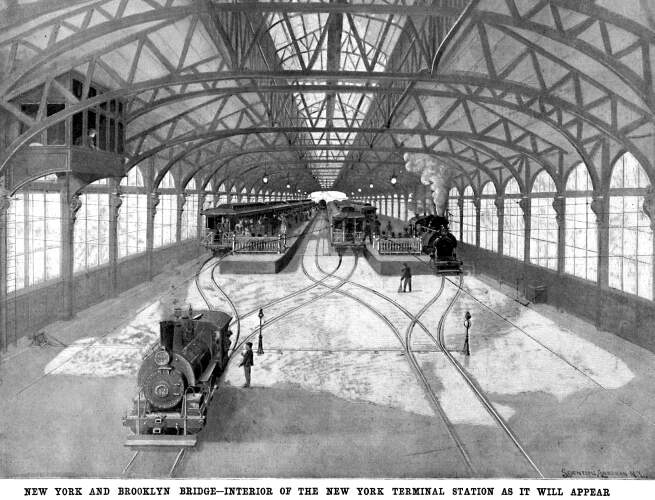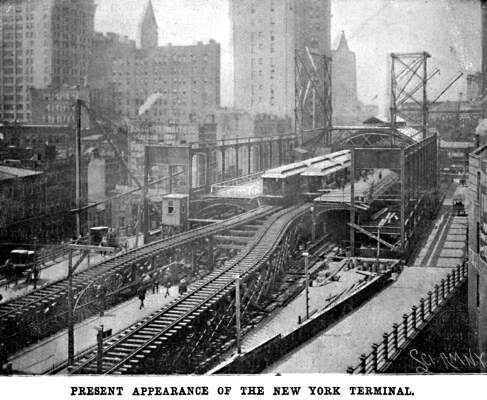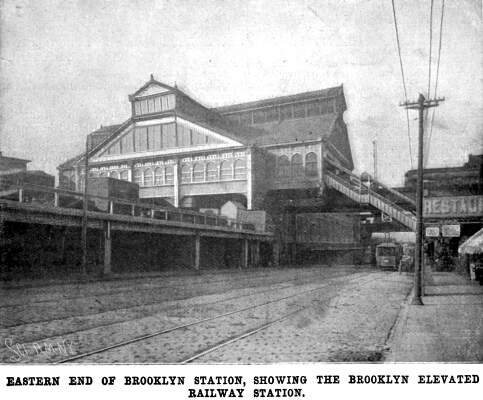
THE NEW TERMINALS OF THE BROOKLYN BRIDGE.
Scientific American—October 19, 1895
Nothing shows more impressively the rapid growth of the metropolis
than the continual and imperative demands for means of transportation
for the hundreds of thousands of people whose business is located
in New York and whose homes are in the adjacent towns. Brooklyn
is the greatest of these cities of residence, and, although means
have been multiplied for transporting the people, still the demand
for greater facilities increases.
Since the opening of the Bridge Railway on September 24, 1883,
the railway has had a carrying capacity of over 200,000 passengers
per day, the largest number for one day being 223,625, which was
October 12, 1892. Since the opening of the railway there have
been numerous alterations and improvements to facilitate the handling
of passengers to the fullest extent under the existing system.
In ten years the facilities proved totally inadequate and greater
capacity being imperatively demanded, the present new system of
operation was devised and the construction of the terminal stations,
which are now partly finished, was begun.
The Brooklyn station, although still incomplete, is farther
advanced than that at the New York end.
We give an engraving of the interior of the New York terminal
station as it will be when finished, the view being taken from
the City Hall or western end of the building. The structures at
the opposite ends of the bridge are practically alike, except
that the Brooklyn station is constructed to accommodate elevated
railroads at either end and at, the side, and is provided with
galleries to permit of passing over the cars and tracks giving
access to the passages which lead to the elevated railroad platforms.
The bridge station of the Brooklyn Elevated Railroad is integral
with the bridge station, and is built by the bridge and leased
by the elevated railroad. The Kings County Elevated Railroad is
provided with structures of its own outside of the bridge station.
 The system of tracks, by means
of which the capacity of the bridge railway is to be practically
doubled, is illustrated in the view of the New York station. The
tracks on opposite sides of the bridge are double, each being
composed of two pairs of rails, one pair of rails on one side
of the bridge leading to the right of one platform, the other
pair of rails leading to the right of the other platform. The
rails of the track on the other side of the bridge are arranged
in a similar way, one pair leading to the left of one platform,
the other leading to the left of the other platform. Arranged
in this way, each train comes in on a track which is contiguous
to the platform, there being no switching. The system of tracks, by means
of which the capacity of the bridge railway is to be practically
doubled, is illustrated in the view of the New York station. The
tracks on opposite sides of the bridge are double, each being
composed of two pairs of rails, one pair of rails on one side
of the bridge leading to the right of one platform, the other
pair of rails leading to the right of the other platform. The
rails of the track on the other side of the bridge are arranged
in a similar way, one pair leading to the left of one platform,
the other leading to the left of the other platform. Arranged
in this way, each train comes in on a track which is contiguous
to the platform, there being no switching.
It will thus be seen that the movements of the train are positive
and that there can be no mishap due to misplaced switches. The
only switches used are those employed for shifting the empty trains
from the incoming tracks to the outgoing tracks. These switches
are to be operated by a man in the elevated gallery shown in the
left of the illustration. At present steam locomotives are employed
in the switching, but an experiment looking to the application
of electric locomotives for this purpose is soon to be tried,
it being desirous to abolish the smoke and noise of the steam.
At present the trains are operated under a headway of one and
a half minutes; under the new system the headway is to be cut
down to forty-five seconds. It has been observed that the platform
is cleared of passengers in thirty seconds on an average, and
it is believed that when the new system is in complete working
order, with the number of trains doubled, the congestion at the
stations will be completely obviated and the capacity of the stations
will be ample for many years to come.
 The City Hall station at the
New York end will cover the site of the old station and extend
beyond it, the railway having been changed already so far as possible,
to adapt it to the new system. This station is rectangular, 521
feet long and 87 feet 6 inches wide. There will be two floors.
On the upper floor will be the tracks and two elevated platforms,
as shown in the illustration, and there will be an intermediate
floor on which will be located the toilet rooms and the ticket
sellers' boxes. There will be six stairways from the first floor
to the platforms, and communication with Rose and William Streets
by means of stairways and elevators. The City Hall station at the
New York end will cover the site of the old station and extend
beyond it, the railway having been changed already so far as possible,
to adapt it to the new system. This station is rectangular, 521
feet long and 87 feet 6 inches wide. There will be two floors.
On the upper floor will be the tracks and two elevated platforms,
as shown in the illustration, and there will be an intermediate
floor on which will be located the toilet rooms and the ticket
sellers' boxes. There will be six stairways from the first floor
to the platforms, and communication with Rose and William Streets
by means of stairways and elevators.
The Brooklyn terminal station, which is already well along
toward completion, is 357 feet in length and 90 feet wide. The
arrangement of platforms and stairways is substantially the same
as that of the New York station.
In the construction of the Brooklyn station 420,000 pounds
of cast iron have been used and 3,400,000 pounds of steel. The
work of erecting these structures at the ends of the bridge has
been carried on without serious interruption of traffic, the old
buildings having been torn down and
the new ones built up while the thousands of passengers have surged
back and forth as usual.
Brooklyn Bridge | Bridge Page
| Contents Page
|







